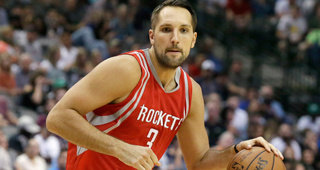While the regular season is a grueling slog that forces teams to think big picture, the NBA playoffs are a different beast. Each game becomes a chess match, where little strategic nuances can be the difference between success and failure. In these previews, we’ll take a look at one intriguing tactical quandary facing each team.
San Antonio Spurs
- Keeping Ryan Anderson quiet
As I mentioned in last round’s previews, Anderson has been a giant force behind Houston’s regular season success. But in the playoffs, Anderson’s game is particularly vulnerable to an opponent with the time, direction and personnel to lock in on him. With the exception of a single game in the series, Oklahoma City virtually made Anderson a non-existent entity.
The primary key for Anderson’s underwhelming performance was the Thunder defense. Often guarded by Taj Gibson, Anderson’s pick-and-rolls with James Harden were often automatically switched. And since (as mentioned in the last piece) Anderson struggles attacking smaller players in post ups, it was up to Harden to break down Gibson or any other OKC big in order to find quality offense.
In fact, the only time Anderson really shook free in the series was when Doug McDermott was slotted onto him. Because of the fear of McDermott being iso’d against Harden on a switch, the Thunder showed off Anderson, allowing him enough space to wriggle free and do this:
The Spurs also have seen Anderson take advantage of pretty much any coverage requiring the big to leave him in order to impact or contain the ballhandler. For example, if Pau Gasol got stuck on Anderson in a transition mismatch, the Spurs would have him “drop” and protect the paint and “X-out” (basically rotate to Anderson) with the other big on the floor -- usually LaMarcus Aldridge. But even this tactic left Anderson open just enough to sink open shots:
The most surefire way for the Spurs to keep Anderson from having an impact -- something they’ve succeeded at in four regular season matchups -- is to switch any pick-and-rolls where he’s the screener. In particular, Aldridge has a puncher’s chance of keep Harden from getting to efficient looks or just passing off to teammates (like Anderson) with a marginal advantage.
The problem for the Spurs is that any non-Aldridge big (if they stay with two traditional frontcourt players), is going to have trouble not getting cooked by Harden. Even doing it routinely with Aldridge puts the Spurs' key frontcourt player at risk for foul trouble. As per usual with San Antonio, they’ll have to execute a bunch a combination of coverages to keep Anderson from contributing like he did in the regular season. If San Antonio can eliminate big games from Houston’s sharp-shooting forward, it will be tough for their opponent to best them in a seven game series.
Houston Rockets
- Is there a way to slow down Kawhi Leonard in pick-and-roll?
In news to no one, Kawhi Leonard is really good at basketball. The Spurs' all-everything forward is about as versatile a threat on offense as you’ll find in the league. But in particular, Leonard is one of the most well-rounded scorers in pick-and-roll situations you’ll find in the league.
Against Houston, that’s caused a myriad of problems. So entering this series, finding a way to somehow contain Leonard in pick-and-rolls has to be one of the Rockets main priorities. So far in the four matchups in the regular season, Houston has gone with pretty much two coverages: a flat show and a standard “drop and over” where the big sags toward the paint and the on-ball defender goes over the top of the screen.
Unfortunately for the Rockets, Leonard has proved adept at beating both coverages. Against a flat show, he’s been able to turn the corner and get to the rim:
And against that “over” coverage, Leonard has shredded both Houston and the entire NBA to the tune of 1.1 points per possession, per Synergy data. Even going under screens and daring Leonard to shoot produces no discernible difference in his production.
The other problem facing Houston as they decide on a plan doesn’t even have to do as much with Leonard as it does his screeners. Switching against the Spurs means that some overwhelmed wing will be forced to battle Aldridge and Gasol in post ups, not exactly a fun proposition for a defense. And on top of that, the Spurs' bigs throw a wrench into any coverage because they’re so good “slipping” the pick in certain situations -- sometimes for their offense and other times to let Leonard gain an advantage on his defender:
If this is starting to seem like the impossible task, well, it might be. There is going to be no “good” way of guarding Leonard in pick-and-rolls. Houston’s best bet this series is to mix up coverages, like a crafty football defense trying to confuse a quarterback. By switching up whether they go over and under and occasionally letting Nene impact the ball off a hard show, Leonard may be thrown off track simply because he can’t predict what his reads are going to be on a given possession.
If Houston is to challenge to the Spurs, slowing Leonard down is essentially. And when it comes to their pick-and-roll defense, sometimes chaos and confusion works better than execution.



